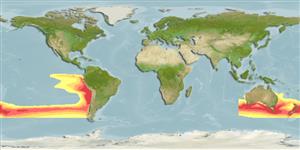>
Carangiformes (Jacks) >
Carangidae (Jacks and pompanos) > Caranginae
Etymology: Trachurus: Greek, trachys, -eia, -ys = rough + Greek, oura = tail (Ref. 45335).
Eponymy: Robert Cushman Murphy (1887–1973) was an American naturalist who became Curator of Birds, AMNH, and was a world authority on marine birds. [...] (Ref. 128868), visit book page.
More on author: Nichols.
Environment: milieu / climate zone / depth range / distribution range
Ecologia
marinhas; oceanódromo (Ref. 51243); intervalo de profundidade 10 - 306 m (Ref. 58489), usually 10 - 70 m. Subtropical; 2°N - 51°S, 106°E - 79°W (Ref. 54929)
South Pacific and Southwestern Atlantic: Eastern Central and South Pacific: off Peru and Chile (Ref. 27363), incl. incidental in Juan Fernández Is. (Ref. 89357). Reported from off Ecuador (Ref. 9283). Southwest Pacific: off New Zealand (Ref. 5755). Southwestern Atlantic: off southern Argentina (Ref. 27363)
Comprimento de primeira maturação / Tamanho / Peso / Idade
Maturity: Lm 40.5, range 39 - 42 cm
Max length : 70.0 cm TL macho/indeterminado; (Ref. 9283); common length : 45.0 cm FL macho/indeterminado; (Ref. 9283); idade máx. registrada: 16 anos (Ref. 26956)
Descrição suscinta
Chaves de identificação | Morfologia | Morfometria
Espinhos dorsais (total) : 9; Raios dorsais (total) : 31 - 35; Espinhos anais: 3; Raios anais : 27 - 29. Body elongated and little compressed; teeth small and uniseriate; lower branch of first gill arch with 42 to 45 gill rakers; edge of shoulders girdle (cleithrum) with a small furrow at its upper end but lacking papillae; lateral line completely scaled, the scales becoming large scutes posteriorly; scutes in the area of the median curve 1.1 to 1.6 times the diameter of the eye; nape and back metallic blue or dark gray; flanks and belly pale; dorsal edge of operculum with a black stain (Ref. 55763). Body elongate and slightly compressed. Body dark blue dorsally, silvery-white ventrally. Black spot on upper posterior margin of opercle. Fins dusky (Ref. 37339). Pectoral fin falcate and very long (Ref. 27363).
Adults are found in the shore and open oceanic waters, in schools. They feed mainly on fish larvae and small crustaceans. Marketed fresh (Ref. 9283). Utilized canned for human consumption and also made into fishmeal (Ref. 9988). The species is often found in Juan Fernández Is. as an incidental catch of Pseudocaranx chilensis (Guichenot, 1848) fisheries (Ref. 89357).
Ciclo de vida ou comportamento de acasalamento
Maturidade | Reprodução | Desova | Ovos | Fecundidade | Larvas
Smith-Vaniz, W.F., 1995. Carangidae. Jureles, pámpanos, cojinúas, zapateros, cocineros, casabes, macarelas, chicharros, jorobados, medregales, pez pilota. p. 940-986. In W. Fischer, F. Krupp, W. Schneider, C. Sommer, K.E. Carpenter and V. Niem (eds.) Guia FAO para Identification de Especies para lo Fines de la Pesca. Pacifico Centro-Oriental. 3 Vols. FAO, Rome. (Ref. 9283)
Status na Lista Vermelha da UICN (Ref. 130435: Version 2024-2)
Ameaça para os humanos
Harmless
Uso pelos humanos
Pescarias: altamente comercial
Ferramentas
Relatórios especiais
Baixar XML
Fontes da internet
Estimates based on models
Preferred temperature (Ref.
123201): 14.1 - 22.6, mean 16.5 °C (based on 352 cells).
Índice de diversidade filogenética (Ref.
82804): PD
50 = 0.5001 [Uniqueness, from 0.5 = low to 2.0 = high].
Bayesian length-weight: a=0.01202 (0.00752 - 0.01922), b=2.93 (2.79 - 3.07), in cm total length, based on LWR estimates for this species & Genus-body shape (Ref.
93245).
Nível Trófico (Ref.
69278): 3.3 ±0.2 se; based on diet studies.
Resiliência (Ref.
120179): médio(a), tempo mínimo de duplicação da população 1,4 - 4,4 anos (K=0.09-0.11; tmax=16).
Prior r = 0.52, 95% CL = 0.34 - 0.77, Based on 1 full stock assessment.
Fishing Vulnerability (Ref.
59153): High to very high vulnerability (67 of 100).
Climate Vulnerability (Ref.
125649): Moderate vulnerability (35 of 100).
Nutrients (Ref.
124155): Calcium = 183 [110, 285] mg/100g; Iron = 3.54 [2.21, 5.69] mg/100g; Protein = 19.1 [18.4, 19.9] %; Omega3 = 0.282 [0.185, 0.424] g/100g; Selenium = 26.8 [16.4, 42.5] μg/100g; VitaminA = 15.8 [3.8, 77.4] μg/100g; Zinc = 2.08 [1.59, 2.88] mg/100g (wet weight); based on
nutrient studies.
